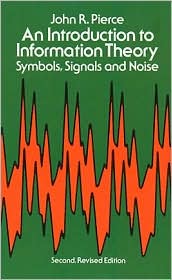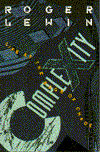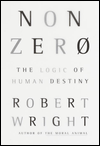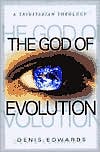Emergent Expectedness, Emergent Evolvability
 |
| Normal Curve or Bell Curve |
The normal distribution which the bell curve depicts also serves to represent many other types of random events, taken collectively in large enough numbers. For example (see p. 99), when scientists make measurements of a fixed quantity such as the exact position of a star in the sky, there are small random errors in the results. To compensate, the measurements are taken over and over again and averaged ... but there are still bound to be variations of the derived averages from the "true" value of the measurement. Those variations, according to the well-known Central Limit Theorem posited in 1810 by Pierre-Simon, Marquis de Laplace, are approximately normally distributed and conform very closely to the bell curve.
In other words, out of randomness comes lawful order. Any one die roll or observational measurement will be anywhere from slightly to nearly totally random, in terms of its expected outcome. A die roll is almost wholly a matter of chance, though no real-world die is perfectly "fair." A star measurement is only a little bit unpredictable; the expected deviation from the "true" measurement will be small, but still random. Yet when you aggregate the rolls of the dice or the observational errors, they conform to a law. When graphed, the data invariably produce a bell shape that can be foretold in advance.
Out of raw unpredictability, expectedness emerges.
Importantly, most of the randomness which Bennett talks about has to do with collections of events in which each event is not only random, but, crucially, it is independent of the other events. If you flip a coin a million times, each single flip's result, heads or tails, depends not one whit on the outcomes of the other flips. It's exactly as if you tossed a million coins all at once. They would each come down heads or tails without regard to what the other coins are doing.
Now, it is this type of independent random event which a genetic mutation is thought to be. That is, when a cell divides to make an egg or a sperm, whether a particular mutation happens or not is purely a matter of chance, independent of any other mutations which may or may not be occurring. The probability of each possible mutation is very, very low. What's more, every possible mutation has the very same probability as every other possible mutation. In this way does standard Darwinian evolution theory provide natural selection with the hereditary variation it needs to produce life's complexity and diversity.
Because independent random events are, when collected in very large numbers, lawful enough to adhere to rules like the Central Limit Theorem and produce bell-shaped curves, there is at least a modicum of expectability in supposedly unpredictable evolutionary history. It is this idea that theoretical biologist Stuart Kauffman builds on and enlarges in his search for laws of self-organization and complexity, as documented in books like At Home in the Universe.
In essence, Kauffman asks what happens if we relax the assumption that the events we are investigating must be independent. If we instead think of each event as carried out by an autonomous entity that is in some form of communication with other such autonomous entities, can we derive yet richer laws?
Autonomous agents in networks of various sorts "transact business" with other agents in the same network, each acting as if seeking to maximize something it covets. For example, Kauffman shows that proteins brought together in a network of shared mutuality can directly or indirectly catalyze one another's reproduction. Each protein, of course, "wants" very much to be reproduced. So the operation of the autocatalytic network makes the chances of successful reproduction of any given protein anything but random.
The protein reproduction "events" will accordingly not produce a bell curve, I assume. But there are other knowable-in-advance curves that such business-transacting networks are apt to generate. One of them is that of a power-law distribution (see Kauffman, p. 29).
A model for this power-law behavior is the "self-organized criticality" of grains of sand dropped one at a time onyo a pile, with the small and large avalanches they occasionally provoke being measured and their sizes plotted. The smaller the avalanche, the more often one of that size can be expected to occur. By contrast, larger avalanches happen less often. When the avalanche frequency is plotted against the avalanche size, the result is a smooth curve that, plotted logarithmically, is a straight line! The size of the "next" avalanche, however, remains always wholly unpredictable.
Out of raw unpredictability, again, expectedness emerges.
The big difference here is that, unlike with dice and other such generators of unpredictability, the grains of sand in a sandpile are, in effect, a loosely coupled network, such that a disturbance to one grain may or may not produce a disturbance to others. Stuart Kauffman's biochemical and biological models are similar to this purely physical model in being loosely coupled networks. When the degree of interactivity of the agents in his network is neither too high nor too low, interesting, lifelike things happen. His agents and their networks evolve.
Out of unpredictability in interdependent, loosely coupled networks, evolvability emerges.
If the degree of coupling is optimal, evolvability is at its most productive. Kauffman finds that the optimal degree of interdependence is one at which the network poises itself at the "edge of chaos."
This edge of chaos is a locus or domain along a mathematical continuum between frozen order and rank chaos. If a networked system has too much frozen order, it can't change and therefore can't evolve at all. If it has too much chaos, it changes too readily and can't evolve gracefully.
Kauffman hypothesizes that the Earth's biosphere and the various ecosystems that make it up are all networked systems that poise themselves at the edge of chaos. He says the "self-organized criticality" of sandpile avalanches suggests their system — the sandpile — is also at the edge of chaos. Accordingly, he posits that the record of such things as sizes of "extinction events" in the Earth's biohistory probably produces a power-law distribution, just as do the sizes of avalanches in a sandpile.
So, if Kauffman is right, unpredictable events that are loosely coupled rather than isolated, as with independent die rolls, again yield emergent expectedness. The big difference is that the emergent behavior is more richly complex than with independent chance events. It may be that this rich emergent complexity is as characteristic of life on Earth, and as lawful, as the lawfulness associated with random mutations culled by natural selection. Self-organization may be natural selection's "handmaiden" in turning emergent expectedness into emergent evolvability.
The lawfulness of independent, purely random events is entirely bottom up. That is, there is no central authority that in any top-down fashion commands the dice to produce a bell curve.
When you switch to networks whose agents are interdependent rather than independent, bottom-up lawfulness likewise emerges. There is no top-down dictator, for instance, that forces a system to produce a power-law distribution of its large-scale events by poising itself at the edge of chaos.
Yet in such a network there is a form of top-down constraint. The sandpile as a whole "decides" whether a dropped grain of sand produces an avalanche, and if so how big. The grains in the avalanche that may thus be produced then have no choice but to slide down the pile.
Likewise in Kauffman's biochemical/biological models, basically autonomous agents are at the mercy of global, collective behavior in the system as a whole.
So systems capable of evolving meld bottom-up behavior with top-down behavior. This may be a precondition for emergent evolvability.
In such a network, if there is too much independence on the part of individual agents, evolvability suffers. Since agents don't take other agents' circumstances sufficiently into account, system-wide evolvability cannot emerge. Though there may be minor change in local areas, it cannot spread. The network as a whole is effectively frozen. There is too much order.
Evolvability also suffers if the agents are too sensitively tuned in to what's going on with too many of their fellows. Instead of being loosely coupled, such a network is tightly interrelated. That can be a recipe for chaos, letting small "earthquakes" in localized areas of the network spread tsunami-like to swamp the network as a whole.
Tyrannical control from on high, with every agent made to march in lockstep to a single drumbea with every other agent, could solve this chaos problem. If the emphasis shifts too much in that direction, though, there is again too much order, and evolvability suffers.
There would seem to be a lesson here. If evolvability suffers from too much order or too much chaos, the system as a whole will fail to adjust to changed circumstances, and will consequently die. Then where will the would-be autocrat be? The overly individualistic agent?
Hence, out of unpredictability can emerge not only lawfulness, but life itself ... and life lessons as well.


















0 Comments:
Post a Comment
<< Home